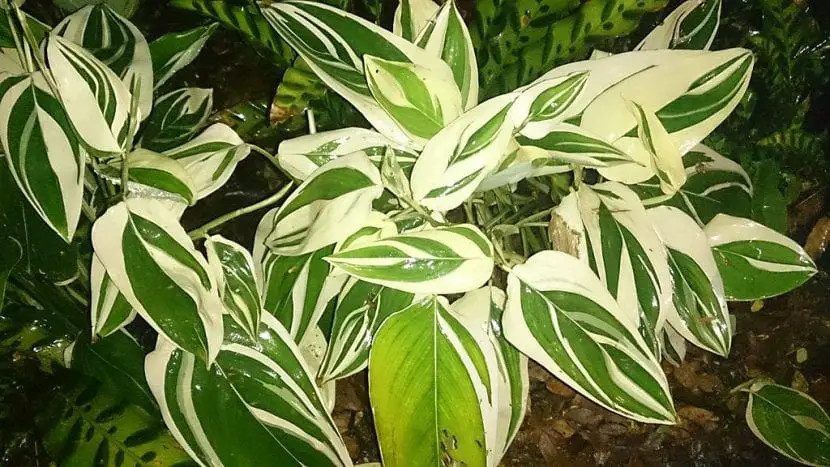
Image – Wikipedia, the free encyclopedia
The plant known as arrowroot It is a beautiful herb that you can enjoy at home, or in the garden if the climate is tropical for several years. Its leaves are simple but incredibly elegant, since they can also be green or variegated.
To keep it in good condition you have to keep some things in mind, since unfortunately it is a bit difficult to have if the temperatures do not accompany it in winter.
Origin and characteristics of arrowroot

Image – Wikimedia / Manuspanicker
It is a herbaceous rhizomatous perennial known as maranta, sago, obedient plant or arrowroot native to the Orinoco basin, where it lives in the tropical forests of the place. Today he is naturalized in Florida.
It can reach a height of 1 meterand develops aerial and branched stems from which sprout alternate and ovate leaves 6 to 25cm long by 3 to 10cm wide, petiolate. The flowers are not very visible, and they are grouped in clusters that arise from the upper part of the stems.
What are the care it requires?
If you want to have a copy, we recommend that you provide it with the following care:
Weather
The maranta reed is a plant that, if you want to grow outdoors all year round, must be in an area where the climate is tropical (minimum temperature of 15ºC), and with a high environmental humidity.
Other options are to have it in a heated greenhouse, at home during the winter or all year round 😉.
Location

Image – Wikimedia / Manuspanicker
- Interior: in a bright room, away from drafts and with high humidity.
- Outdoor: protected from direct sun.
Earth
- Flower pot: fill with fertile substrate, with good drainage. For example, a good mix would be 70% mulch with 30% perlite or the like (arlite, akadama, etc.). You can get the first here! and the second here!.
- the garden: the soil must be rich in organic matter and light, with a neutral or slightly acidic pH (pH between 5 and 6.5).
Irrigation
The frequency of irrigation will depend a lot on the location and the characteristics of the climate. For instance: if it is kept indoors, it will be necessary to water considerably less than if it was kept outside, since the soil takes longer to dry. So to avoid problems, it is highly advisable to check the humidity of the soil before watering, with a digital meter, a stick or weighing the pot once watered and again after a few days.
It uses rainwater, without lime or, failing that, suitable for human consumption. You can also acidify it if the one you have is very calcareous, diluting the liquid of half a lemon in 1l of water. Measure the pH with specific meters (for sale here!), so it doesn’t go too low.
Subscriber
From early spring to late summer It must be paid with an organic fertilizer following the indications specified on the packaging. In the event that you only use it as an ornamental plant, you can fertilize your arrowroot with compound / chemical fertilizers, such as the universal one for plants (for sale here!).
Planting or transplanting time
In springwhen the risk of frost has passed. If you have it in a pot, move it to a larger one if you see that roots are coming out of the drainage holes, or if it has been a long time (2 years or that) and you have stopped noticing growth.
Multiplication

Image – Wikimedia / Kakara
Arrowroot multiplied by division of kills in spring. As it has a rhizomatous root system, it is relatively easy to get new specimens of the same plant. To do this, what is done is the following:
Potted plant
If you have it in a pot, remove it and with the help of a previously disinfected serrated knife, divide the plant into 2 or 3 three depending on its size.
Plant in the garden
If you have it in the garden, dig some ditches about 30 centimeters, water them conscientiously and then, with the help of a laya (it is a kind of shovel, but more rectangular and straight; you will find it for sale here!) you can divide the arrowroot.
Pests
It is sensitive to attack by Red spider and to the mealybugs. They both love hot, dry environments, so one way to prevent them is by keeping moisture around the tall plant, either with humidifiers, with glasses of water around it, or by spraying the leaves with lime-free water from time to time. when in spring and summer (in autumn-winter I do not advise it, since as it is barely active, it is easy for it to rot).
If there is plague, then treat with diatomaceous earth for example, or cleaning the leaves with water and neutral soap.
Diseases
When overwatered, or if kept in a pot with a dish underneath that is always full of standing water, the mushrooms will not take long to appear, rotting the roots and causing their leaves to have brown or blackish spots.
The best treatment is prevention, controlling the risks and avoiding spraying daily. But if there are already symptoms, let the soil dry out and treat with a copper-based fungicide.
Rusticity
It does not support cold or frost.
What uses is it given?

Image – Wikimedia / Noblevmy
Ornamental
Arrowroot it is a very beautiful plant, ideal to have in the tropical garden or indoors. It is not very easy to take care of, that is true, but it is not one of the most difficult either 😉. With the advice we have given you, we hope you can enjoy it for a long time.
Culinary
The roots are rich in starch (around 23%). They are used in the form of cakes, jams, cakes, puddings, even as syrup once cooked.
Did you know this plant?
